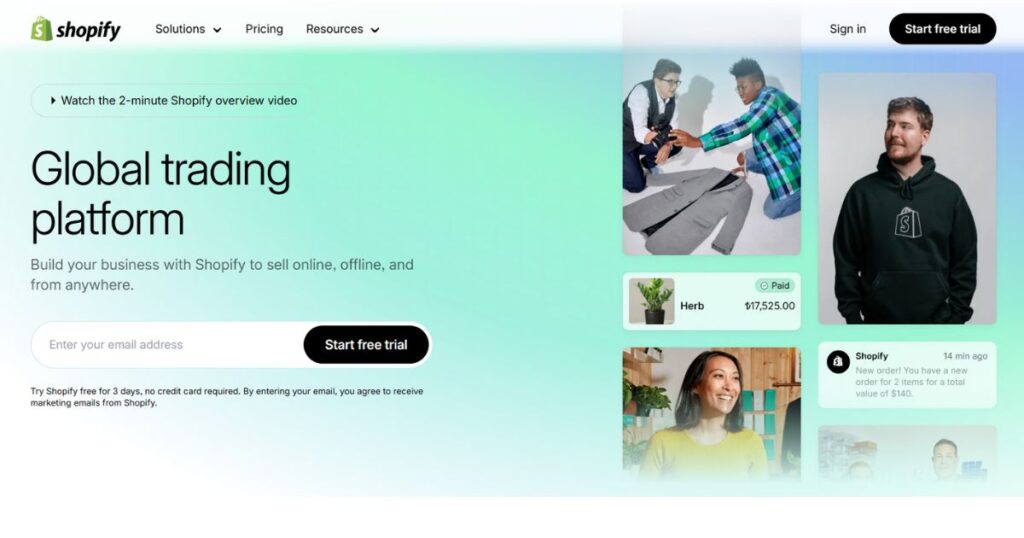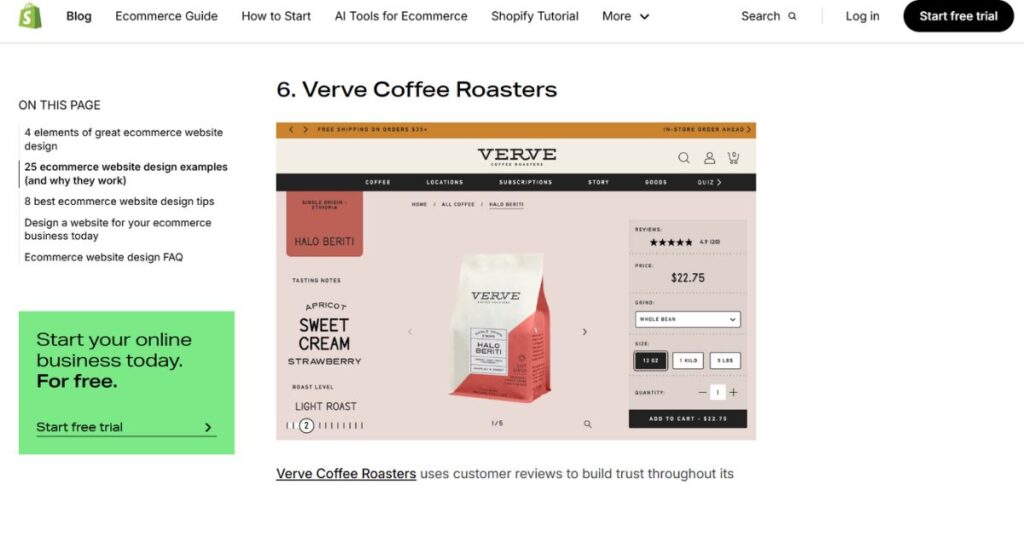In this Shopify article, I share How Can You Make Money with Shopify and growing your online store easier. Have you ever wondered, With over 1.7 million businesses worldwide, Shopify is more than just an ecommerce platform it’s a launching pad for a multitude of income streams.
In this article, I’ll guide you through 13 actionable strategies that cover everything from starting your own store to leveraging your social media following. Whether you’re a budding entrepreneur or a seasoned expert, these ideas will inspire you to explore diverse avenues and turn your passion into profit in this new year. Here’s the way how can i make money on shopify.
How Can You Make Money with Shopify
1. Start a Shopify Store
Imagine you’re ready to dive into ecommerce but don’t want to get overwhelmed with technical details. That’s where Shopify comes in! You can sign up for an account, pick one of their easy-to-use themes, and follow their step‑by‑step guides. It’s really a “set it and forget it” kind of start.

SEO Matters: Do a little keyword research (there are plenty of free tools out there) and sprinkle those keywords into your product titles, descriptions, and blog posts. The goal is to help people find you on Google without needing a massive marketing budget.
Keep it Simple: Get your store up and running with basic elements great product photos, clear descriptions, and a user‑friendly layout.
Payments and Shipping: Set up Shopify Payments (or another option you prefer) and configure shipping settings. There are built‑in tools and apps to help manage inventory and track orders.
2. Buy or Acquire a Shopify Store
Not everyone wants to build something from scratch and that’s totally fine. Sometimes the smart move is to buy an already‑established store.
- Check Out Marketplaces: Websites like Flippa or Empire Flippers list Shopify stores for sale. You’ll see details like monthly revenue and traffic, so you can compare different opportunities.
- Do Your Homework: Look closely at how the store’s doing. Is it in a niche that interests you? How are the sales trends? Make sure you understand the numbers and any potential challenges before making an offer.
- Due Diligence Is Key: Make sure to verify financial records, check out any ongoing costs (apps, subscriptions, etc.), and understand any legal agreements in place. It might help to chat with an accountant or business advisor to make sure everything adds up.
3. Start a Shopify Dropshipping Business
Dropshipping is a great way to test the waters in ecommerce without needing to invest in inventory upfront. It’s like being a middleman but you still earn a profit when someone buys from your store.

- Low Risk, High Reward: With dropshipping, you list products on your Shopify store, but your supplier takes care of storing and shipping them. This means you don’t need to spend a lot on stock that might not sell.
- Find Reliable Suppliers: Use dropshipping apps (like Oberlo or DSers) that connect directly with Shopify. These tools help you find suppliers with good reviews and reliable shipping.
- Market Your Store: Even though you’re not handling the products yourself, you still need to drive traffic. Use targeted marketing techniques like social media ads, influencer partnerships, or even small-scale ad campaigns on Facebook and Google to see what works best for your niche.
4. Become a Shopify Affiliate Marketer
If you’ve got a blog, a YouTube channel, or a loyal social media following, consider becoming a Shopify affiliate marketer. Here’s how you can get started.

- Join the Affiliate Program:
It’s free to sign up for Shopify’s affiliate program, and many affiliates earn a solid commission (some say around $150 for every referral who signs up for a paid plan). Before you apply, make sure you meet the basic requirements like having an active website or an engaged audience. - Create Engaging Content:
Share your personal experiences and insights through blog posts, videos, or guides that explain how Shopify can help entrepreneurs succeed. Tell stories, include real-life examples, and even sprinkle in a few case studies. This isn’t just about listing features it’s about showing people why Shopify might be the perfect tool for their business. - Leverage Your Existing Audience:
Use your social media profiles, email newsletters, or even live sessions to promote your affiliate links. The goal is to naturally guide your audience to Shopify by showing them how it works and why it matters. And don’t forget to keep an eye on your analytics so you know which content resonates the most with your followers.
5. Be a Shopify Expert
If you’re handy with design, development, or digital marketing, you can turn those skills into a thriving business by becoming a Shopify expert. Here’s a friendly roadmap to help you get started.

- Offer Specialized Services:
Think about what you do best whether it’s crafting a stunning store design, coding custom features, or running killer marketing campaigns. Package your skills into services that help Shopify merchants boost their sales and improve their customer experience. - Apply to the Shopify Partners Directory:
Once you’ve defined your niche, create a professional profile in the Shopify Partners Directory. This is where merchants go looking for experts like you. Make sure your profile includes a portfolio of your work, case studies, and testimonials from happy clients. It’s all about showing potential customers the real, tangible results you can deliver. - Build and Grow Your Portfolio:
Start small if you have to maybe offer free consultations or work on smaller projects until you’ve built a solid portfolio. Over time, update your website with before-and-after examples, client feedback, and measurable outcomes. Networking with other professionals and participating in Shopify-related forums or webinars can also help you stay on top of trends and continually refine your skills.
6. Start a Fashion Brand
If fashion is your passion, Shopify is an amazing platform to launch your own clothing or accessories brand. Here’s how you can transform your creative ideas into a successful business:
- Set Up Your Store:
Choose a Shopify theme that matches the vibe of your brand, and don’t stress too much about having the perfect design right out of the gate. Many entrepreneurs start with a simple setup and refine it as they grow. You can also connect your store with print-on‑demand services or dropshipping partners to manage production without needing a warehouse. - Develop Unique Designs:
Whether you’re designing your own apparel or curating exclusive collections, focus on creating products that truly stand out. Think about what makes your designs special maybe it’s the quality, the story behind each piece, or simply the unique style that only you can offer. Test different products, listen to your customers, and adjust your offerings based on what resonates most with your audience. - Build Your Brand and Social Media Presence:
Your brand isn’t just a logo or a color scheme it’s the personality behind your business. Craft a story that connects with your target audience and share it on platforms like Instagram, Pinterest, and TikTok. Post behind-the-scenes looks at your design process, collaborate with influencers, and use engaging visuals to capture attention. Don’t forget to build an email list as well sending out updates, style tips, and exclusive offers can turn casual visitors into loyal fans.
7. Offer Product Photography Services
In the ecommerce world, visuals are key. High‑quality product photography not only enhances customer trust but also boosts conversion rates by clearly displaying a product’s features and quality.
Key Points:
- Market Demand:
- Recognize that online shoppers rely heavily on crisp, professional images to make purchasing decisions.
- Capitalize on the growing demand for quality product photography by offering services specifically for Shopify stores.
- Service Offerings:
- Provide complete photography packages—from professional photo shoots and image editing to optimization for web and mobile use.
- Include services such as 360‑degree views, lifestyle shots, and detailed close‑ups that emphasize product features.
- Impact on Conversions:
- Explain how clear, high‑resolution images can boost conversion rates (studies suggest improvements up to 30%) and reduce return rates by setting accurate expectations.
- Emphasize the role of optimized images in building brand trust and elevating the online shopping experience.
8. Build Shopify Apps or Themes
Develop custom apps or themes to extend the functionality and visual appeal of Shopify stores. This technical niche offers a way to monetize your development skills while helping merchants improve their online businesses.
Key Points:
- Development Opportunities:
- Leverage Shopify’s powerful APIs and the Polaris design system to create custom integrations, apps, or themes tailored to merchants’ needs.
- Focus on building solutions that solve common ecommerce pain points whether it’s enhancing store design, streamlining the checkout process, or automating tasks.
- Monetization Strategies:
- Monetize your creations by listing them on the Shopify App Store, offering them as white-label solutions, or providing bespoke development services directly to store owners.
- Consider offering tiered pricing models (e.g. freemium versions with premium features) to attract a wide range of merchants.
- Technical Excellence:
- Stay up to date with Shopify development trends, participate in the developer community, and continuously improve your technical skill set.
- Ensure that your solutions are user‑friendly, well‑documented, and scalable
9. Monetize Your Social Media
Imagine turning your Instagram, Facebook, or TikTok account into a revenue‑generating engine. By linking your Shopify store to these platforms, you can drive real traffic straight to your product pages.
The trick is to use your existing social following to share your brand story post eye‑catching images, behind‑the‑scenes videos, and regular updates that invite your audience to shop.
Think about using features like Instagram Shopping or TikTok’s shoppable posts. You can even team up with influencers who genuinely love your products. The goal is to create engaging, shoppable content that doesn’t just attract likes, but also converts those interactions into sales.
10. Offer Your Freelance Service
If you’re skilled in areas like copywriting, design, SEO, or web development, why not offer your services to Shopify store owners? Many merchants need expert help but don’t have the in‑house talent to get their store looking or performing its best.
By joining Shopify’s Partner Network or platforms like Upwork, you can showcase your previous work, share success stories, and build a portfolio that demonstrates real results.
When you highlight case studies and testimonials from past projects, potential clients see the value you bring, making it easier to secure freelance gigs and build lasting relationships.
11. Sell Print‑On‑Demand Products
Print‑on‑demand (POD) is a fantastic way to start selling custom merchandise like t‑shirts, mugs, and tote bags without the headache of holding inventory.
With a POD model, you create unique designs that resonate with your audience, and a third‑party service takes care of printing, packing, and shipping.
This means you can focus on what you do best design and marketing while the production side is handled for you. The key is to experiment with creative, original designs that stand out, and to continuously gather feedback from your customers so you can refine your offerings.
12. Set Up an Online Storefront for a Local Business
Many brick‑and‑mortar businesses are looking for ways to grow online, and you can help them bridge the gap. By setting up an online storefront using Shopify, you offer local shops a chance to expand beyond their physical location.
The idea is to create a seamless experience customers can shop online and either have their items delivered or pick them up in‑store.
This integration can involve using Shopify’s built‑in tools for inventory management, local SEO, and even click‑and‑collect services. It’s all about creating a unified shopping experience that makes the transition from offline to online as smooth as possible.
13. Sell Digital Products
Do you have expertise you’re passionate about? Consider creating and selling digital products through your Shopify store. Digital products like ebooks, courses, or templates are great because once you create them, they can be sold again and again with little extra work.
Use Shopify’s digital downloads feature to deliver these products instantly, ensuring your customers get immediate access.
Focus on creating high‑quality, evergreen content that addresses common problems or offers unique insights, and you’ll build a steady stream of passive income. Over time, you can expand your digital product line and refine your offerings based on customer feedback and performance data.
Final Thoughts
If you’re following all this 13 ways in my blog, you’ll already to start it, I’m a big fan of Shopify. I truly believe Shopify is best eCommerce platform you can make money as many ways!There are numerous ways to answer the question, “how can you make money with Shopify?” By exploring strategies from launching your own store and dropshipping to becoming a Shopify expert and selling digital products, you can find the right fit for your skills and passions. Start implementing these ideas today and take your first step toward building a profitable Shopify business in 2025. Ready to get started? i recommended you






